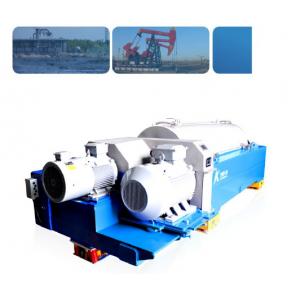

Add to Cart
At present, the oily (waste) water generated in the course of processing crude oil in the refinery is often treated by rough flocculation + dehydration. The slag phase is directly incinerated after dehydration. This treatment mode causes waste of crude oil resources. Now we can apply a series of pretreatment processes (adding demulsifier, surfactant, etc.) and then use the high-efficiency LWS series three-phase centrifuge to realize the reuse of crude oil resources.
After the oily (waste) water is collected, a suitable amount of demulsifier, an active agent, etc. are added, so that the oily water in the emulsified state is broken, and the oily (waste) water after demulsification is naturally settled and separated in an oil trap. The water in the middle layer of the oil trap and the oil-water mixture not demulsified are directly sent to the sewage treatment system for treatment. The task of dehydration can be completed by the high efficiency LW series two-phase centrifuge. The oil floating on the upper layer of the oil trap and the sludge settled on the bottom layer are collected and sent into the stirring tank for further treatment. The oil, water, and slag in the oily sludge treated can be separated continuously from each other through the high-efficiency LWS series three-phase centrifuge.
For the treatment of oily (waste) water, the purpose is to recover more oil and reduce the oil content in the solid. Therefore, the role of each section in the whole process system is very important.
1. Demulsifier and surfactant can improve the efficiency of demulsification, enhance the subsequent separation efficiency, increase the oil recovery rate, and reduce the oil content in the slag phase.
2. Heating can reduce oil viscosity, improve the oil recovery rate, and lower the solid contents of oil and water.
3. Adding PAM flocculant can increase the solid recovery rate and reduce the solid content in the liquid phase.
4. Separation of oil, water, and slag with the high-efficiency LWS series three-phase centrifuge can improve the separation efficiency, enhance the oil recovery rate, and reduce the oil content of the slag phase.
5. Solid-liquid separation realized by using a high-efficiency LW series two-phase centrifuge can reduce the liquid content of the slag phase, facilitate transportation, and increase the combustion heat value.
Separation performance:
1,About 80~95% oil can be recovered (relating to oil density, demulsification effect, temperature, etc.), and the recovered oil can be used for refining purpose after further purified by the flottweg separator;
2,The water content of the oil phase after separation can reach ≤3 ~ 5%;
3,The dryness of the slag phase after centrifugation can reach 40 ~ 60%, and its total volume is reduced by over 80% compared to that before separation;
Oily wastewater treatment flow chart
Item | Unit | LWS250×1025B(X) | LWS350×1435B(X) | LWS450×1845B(X) | LWS520×2150B(X) | LWS580×2400B(X) | LWS650×2600B(X) |
Throughput | m3/h | ≥1 | ≥3~5 | ≥5-10 | ≥10-15 | ≥15-20 | ≥20-30 |
Roller diameter | mm | 250 | 350 | 450 | 520 | 580 | 650 |
Length-to-diameter ratio | 4.1 | 4.1 | 4.1 | 4.1 | 4.1 | 4 | |
Speed | rpm | 5000 | 4000 | 3500 | 3200 | 3000 | 2800 |
Separation factor | 3500 | 3136 | 3087 | 2982 | 2948 | 2854 | |
Differential speed | rpm | 1~50 | 1~35 | 1~34 | 1~34 | 1~30 | 1~27 |
Main motor power | kW | 11 | 22 | 30 | 45 | 55/75 | 75/90 |
Ancillary motor power (kW) | kW | 4 | 5.5 | 7.5 | 15 | 18.5 | 22 |
Weight | kg | 1250 | 2500 | 4000 | 5200 | 6500 | 8000 |
Boundary dimension (L×W×H) | mm | 2500×800×1150 | 3700×1050×1400 | 3800×1150×1600 | 4800×1250×1800 | 5300×1750×1382 | 5600×1850×1500 |
Item | Unit | LW250×1025B | LW350×1435B | LW450×1845B | LW520×2150B | LW580×2400B |
Throughput | m3/h | 0.5-3 | 3~10 | 8~15 | 15-20 | 20-30 |
Roller diameter | mm | 250 | 350 | 450 | 520 | 580 |
Length-to-diameter ratio | 4.1 | 4.1 | 4.1 | 4.1 | 4.1 | |
Speed | rpm | 5000 | 4000 | 3200 | 3000 | 2800 |
Separation factor | 3500 | 3136 | 2580 | 2620 | 2546 | |
Differential speed | rpm | 1~50 | 1~35 | 1~34 | 1~34 | 1~36 |
Main motor power | kW | 11 | 22 | 30-37 | 45-55 | 75-90 |
Ancillary motor power (kW) | kW | 4 | 5.5 | 7.5 | 15 | 18.5 |
Weight | kg | 1250 | 2500 | 4200 | 5200 | 6500 |
Boundary dimension (L*W*H) | mm | 2500×800×1150 | 3700×1050×1200 | 4300×1150×1450 | 5100×1250×1600 | 5520×1450×1700 |
| Note: The throughput is related to material characteristics. | ||||||
